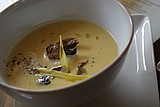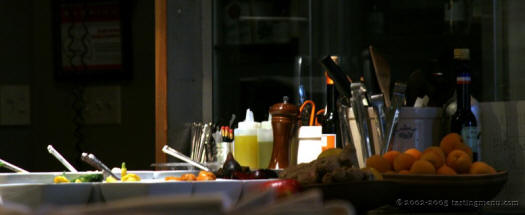Home |
Restaurants by City
|
Food Photography |
Archive | Philosophy |
![]()
Right now we are eating in Seattle, Washington.
|
Tuesday
2005
Permalink
|
The Inn at Langley, Whidbey Island, Wa, tasted on July 7, 2005 — Given that I can't travel all year long it can be hard to visit places more than once. And while many people who write about food think that it's unfair to write about places you ate at once, I don't really have a choice. I figure that you can't be worse than your worst day and you can't be better than your best. And given that I'm looking for places with a healthy dose of consistency, they should fare just fine. In this spirit, a little while ago I posted about our visit to the Inn At Langley last year. The next day we went back and had dinner again at the Inn at Langley's restaurant hosted by their resident chef - Matt Costello. What difference did a year make? Well, it's kind of funny. In one way the meal we had was completely consistent with the first meal we had about a year ago. Overall, quite enjoyable. On the other hand the context of revisiting the restaurant was valuable as well. The things we liked were just as good if not better, and the things we didn't love, well, now we were certain of it. Dinner started off with an amuse of Marinated Anchovies on Tomato Chutney with Lovage. Fishy spicy sour but clean. This was like fish sauce but with no Asian overtones. The dish was striking. And the tiny strips of lovage were surprisingly flavorful with their celery-ish tones. This was followed by Chilled Sweet Corn Soup with Sweet Onion Panna Cotta. The soup was cold but the flavor was warm. It was beautiful to look at too. Just sweet fresh corn taste. If I had one complaint it would be that I couldn't taste the onion in the otherwise yummy panna cotta. I wish I could have. I bet it would have made it even better. The salad was Baby Beets and Figs with Orange Confit and Vanilla Vinaigrette. As with last time, the rule of three was operative here in a couple of dishes. Three flavors making interesting combinations. Each has to be a great counterpoint to the other two. And this is what makes it interesting. I also liked that none of the items were the star. Each shared the stage. I am not a big fan of fig or orange confit but these were both quite good. And as for beets, I'm pretty sure that I am completely, deeply, and passionately in love with them. Palate cleansing was on the menu next with Apricot Sorbet with Muscato and Lemon-Flavored Herbs. The sorbet was very good. The herb counterpart helped. Typically flowery overtones are not my thing, but here they were complementary and quite good. This was excellent. It was at this point in the meal that the juxtaposition of the two experiences really made it clear to me that Chef Costello is providing (what I imagine to be) a true Whidbey Island experience on his plates. It sounds so trite and cliché to say that a chef is trying to express the region around him in his dishes, but in an unassuming, and not pretentious way, that's exactly what this food was. Simple. Not hyper-original-on-the-edge, but not run-of-the mill by any means. Structured, colorful, balanced, and frankly fresh, clean, and interesting like the air on the Island. Remember, interesting is important. It was also clear to me when the entrees came why I'm a small plate fan. One of the entrees was the Halibut with Potato-Cauliflower Puree, John Peterson's Cabbage and Penn Cove Mussels. The other choice was the Roasted Pork Loin on Local Green Beans with Tiny Zucchini and Tomato-Red Wine Sauce. I have no doubt that if Chef Costello had pared these dishes down to the size of the previous ones, they would have shined. But there is something about the entree where I think chefs can lose focus and try to do too much on the plate. On the plus side, the pork crust was super savory and the various beans and zucchini were perfect. The sauce was good too but the pork, unfortunatley was, overcooked and dry. With the halibut there was interesting seasoning, but the fish itself was not very interesting in flavor or texture. The cabbage underneath however was excellent. Instead of giving everyone a choice of the entrees, why give everyone both at 1/3 the size. I bet they'd come out way way better. Again it was impossible not to notice that the Chef was doing basically all the cooking by himself. Neat! Luckily the cheese plate again reminded me of how good the dishes there could be. The cheese course consisted of Brillat Savarin Cheese with Cherry Crepes and Shallot Jam. Rather than featuring the cheese with some bit players as accompaniments (even carefully prepared bit players), Costello makes the cheese share the stage with two other items served in (relatively) generous proportions. In this case the theme could have been "bitter" in a good way. The cheese, cherries, and shallots all had that undertone, It was really quite enjoyable especially in constrast with the soft texture of the blintz. And finally for dessert we had Rum-soaked Almond Cornmeal Cake with White Peach Sorbet and Rum Custard. This was really nice as each element of the dessert had a completely different yet entirely cream texture. Entrees aside, we really enjoyed our meal at the Inn At Langley. Chef Costello is obviously super talented. And in some ways he has found a pretty unique voice in terms of his cooking. In a time when even the most cutting edge restaurants can often seem to be derivative and repetitive, Costello doesn't hesitate to make his food and say something about his surroundings. I have a feeling that the areas that weren't quite as enjoyable go against his grain. I can't get inside his head, but I think chefs often serve these entrees because they're expected by the typical restaurant diner. I bet if Costello really let loose, the entrees would disappear and the meal would be elevated that much further. If that were to happen I bet we'd make the long trek out to Whidbey Island more than once a year.
|
|||
Our Sponsors
Free Car Listings – Hot Tubs – Stools – Saunas – Bar Stools - Calendar and Event Schedules - Food Events and Calendars - Wine Events and Calendars - Digital Photography Resources - Software for Advertisers - Jewish Gifts and Judaica - Howard Stern Podcast - ponytailed blogger Jonathan Schwartz

Browse tastingmenu
Home |
Restaurants by City X |
Food Photography |
Archive | Philosophy |
![]()
Free eBooks: All About Apples
| Autumn Omakase
More:
Discussion |
Cool Food T-Shirts |
Ingredients
| Markets |
Recipes
Search |
Blog FAQ |
Other
Blogs
Best of tastingmenu
|
City View
Entry: July 6, 2006 |
Blue Plate
Entry: June 19, 2006 |
L'Atelier de Joël Robuchon
Entry: July 18, 2006 |
Browse by City
Boston | Chicago | Houston | Las Vegas | Los Angeles | Maui | New York | Philadelphia | Portland | San Francisco | Seattle | Toronto | Utah | Vancouver | Washington D.C.
Bangkok | Beijing | Hong Kong | Seoul | Tokyo
Amsterdam | Berlin | Italy | London | Madrid | Paris | Vienna
Browse by Month
2006
2005
2004
2003
2002
2001
Comments, questions, or feedback:
info / at / tastingmenu / dot / com
All pages Copyright (c) 2001-2006 tastingmenu.com
Last modified 01/30/07.





